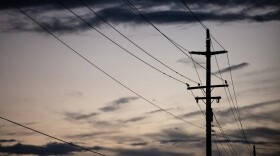Updated June 27, 2025 at 13:39 PM ET
Sam Droege rummages through the buckets, boots, and vials in the trunk of his car before grabbing a net and striding into Kenilworth Park South on the edge of Washington, D.C., atop what was once a landfill.
He's here to catch bees — not honeybees, but all manner of other bees. "Most of them, there's no stinging," he says. "There's no allergic reactions."
Droege stops at a blackberry patch. Its flowers sway in the breeze. His expert eye immediately snags on a tiny bee half the size of a grain of rice. "Most bees are super small," he says.
And yet, these teensy insects play an outsize role in pollinating all sorts of plants, including ones we grow and eat. Droege has estimated that here in the mid-Atlantic, every acre on average produces some 26,000 bees a year. "Those little bees, they're running the world," he says with a note of respect.
Droege is with the U.S. Geological Survey, where he heads up the Bee Lab, an outfit that supports researchers at other government agencies and universities who study native bees. His work falls under the Ecosystems Mission Area (EMA), a program that helps the federal government manage and conserve wildlife and the natural environment nationwide.

This program, like many of the species it monitors, is now under existential threat: Buried inside the Trump administration's proposed 2026 budget is the near-elimination of the EMA.
NPR reached out to the Office of Management and Budget to confirm the planned cut. In an email, a spokesperson replied, "The Ecosystem [sic] Mission Area is loaded with woke programing [sic]... This is obviously irrelevant to science and is exactly the kind of waste President Trump ran on rooting out of the federal government. It also duplicates several other government programs that do ecosystem research."
But career scientists are deeply worried about the potential cut and sharply disagree with the OMB's characterization, saying that the program is unique in how it gathers such vital information on a national scale.
The birds and the bees
Jill Baron, an ecosystem ecologist at Colorado State University who helped create the EMA in the mid-90s, says the group's work is essential. "There is no redundancy in the monitoring data sets we collect and maintain on species or ecosystems," she says. "No one else collects these data on wildlife, fish, diseases — no one."
When Baron and her colleagues proposed the reorganization that ultimately led to the EMA a few decades ago, they felt "this would be a more appropriate way to tackle grand societal questions than what we'd had before," she says, including those associated with water, energy, minerals, and natural hazards.
Baron points to her own 43-year research study of the Rocky Mountain National Park watershed. Early on, she and her team were looking for evidence of acid rain. Instead, they found excess nitrogen coming from air pollution.
The U.S. Environmental Protection Agency and Colorado's Department of Public Health and Environment then stepped in to reduce pollution levels with support from the National Park Service. And more recently, she has detected climate change impacts on the watershed.
"So these long-term monitoring records allow you to continue to follow what's changing," Baron says. "If you stop monitoring, you not only can't see if the changes are getting worse, you can't see if the actions actually made a difference."
The EMA's purview includes monitoring bats, amphibians, fisheries, environmental contaminants, and wildlife diseases. They count migratory waterfowl "so that each year they can set the regulations for how many ducks, geese, swans they're going to allow states to hunt," says Droege. "So we work on problems that impact the nation as a whole. Someone needs to be looking at the bigger picture than what states and academics can often do."
As for Droege, he and his team help states identify which bees are rare and in need of protection. He also spends a lot of time helping people across the country catch bees and then identify them. "We're here to advise and help people do a better job to understand what kind of bees are around, how they're doing, what their status is." Often, bees will be spotted in places they've never been seen before.
"You have to basically parse huge chunks of the landscape to get some kind of understanding of where bees are and where they're not — and that informs how to help bees," says Droege. "It's not something that can be done in a laboratory. You gotta walk a lot of spots."
Droege speculates the government's decision to slash the EMA has to do with a drive to deregulate, since the group's research into different species helps inform management decisions that limit the use of land and natural resources.
"There is a desire to have less information about plants and animals that could result in endangered species being created," he says. "If you don't know anything, you don't have a problem, so having this kind of information is really inconvenient to business."
That's in spite of the fact that sometimes species are actually more common than we thought — which can lead to less regulation. In these instances, "we're actually keeping things off endangered species lists," says Droege.
Of floods and fires
In addition, the EMA helps protect Americans from natural disasters, including flooding, landslides, hurricanes and fire. "So if you lose EMA, it really fundamentally changes our ability to understand and react to and respond appropriately to these challenges that seem to be expanding every day," says Paul Steblein, who retired late last year from his position as the wildland fire science coordinator under the EMA.
"Cutting a few million dollars is going to have billions of dollars of impact, it's going to affect people's lives," he says. "It's going to affect their health. I think it's shortsighted."
John Organ, the former chief of the Cooperative Fish and Wildlife Research Units within the EMA, says the outcome of cutting the program would be catastrophic. "This will have a cascading effect to the state fish and wildlife agencies who use the units as a research arm, the non-governmental organizations that rely on that science to do their work, as well as local communities because of the impact on jobs and hiring," he says.
"It'll take a generation or more to build these things back up," Organ adds.
A bee's life (and afterlife)
Meanwhile, back in Kenilworth Park South, Droege, with a flick of the wrist, whips his net through the blackberry flowers. He's scanning for the minute activity of bees. "You're just looking for a motion that is different from the plants moving around," he says.
Soon, Droege spots one. "See there's that little bee, right there?," he says. "And I have to be fast because bees are really fast."

Within minutes, he's got a couple dozen bees in his vials, which he'll bring back to the lab to ID them, which involves a gentle washing and drying. "We whirl them around until they're nice and fluffy," Droege says.
They'll then join a collection of some 800,000 bees that the EMA and the researchers they've partnered with have amassed over the decades.
Droege says he and his colleagues are now racing to make sure that their vast bee library is safe. "We're shipping things off, we're pulling things out of freezers, we're making sure that the specimens move into glass-top cabinets or glass-top drawers where they will be safe from rodents and insects," says Droege.
All this, in case their work is suddenly shuttered.
"This is our life," says Droege. "I would do this without being paid — which I very well may."
Copyright 2025 NPR







